Foreign Insulators
by Marilyn Albers
Reprinted from "Crown Jewels of the Wire", August 2000, page 14
MORE ON UKRAINIAN INSULATORS
Seven new glass insulator styles from Ukraine have made their way to the
U.S.A. since the most recent article on "Foreign Insulators" was
published in the June 2000 issue of Crown Jewels of the Wire magazine. There are
some beautiful pieces among them. Four of the insulators are skirt embossed with
Russian letters, which I've translated to English, though I still don't know
what they mean. All seven of the insulators have inner skirts, threaded pin
holes and smooth bases. Thanks to N.R. "Woody" Woodward, each of them
has a new CD number, so let's take a look.
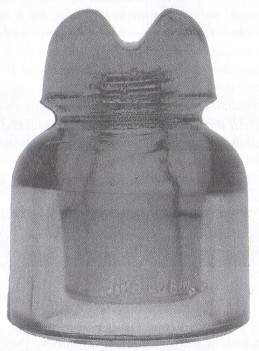
New CD 540.4
This insulator in medium green is very thick and heavy. It is 4-5/8"
tall and has a base diameter of 3-1/2'" The skirt embossing on this one
becomes "LIB.OBSHCH" when translated into English. I have no idea what
it stands for but it is probably the name of the factory that produced it.
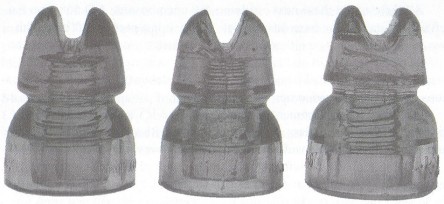
Three new CD 547's
The glass color of all three CD 547's is a medium green. The insulator on the
left in the photo is 3" tall with a base diameter of 2-1/4". The
embossings on both the front and rear skirts have been converted to English.
Thus "HBMAHB 3" is on the front skirt with "OXPAH SSID.No
49515" in the same location on the opposite side.
CD 547 in the center of
the photo is also 3" tall with a base diameter of 2-1/8". The English
translation of the skirt embossing is "E.GOLCBBEB".
CD 547 to the far
right is 3-1/4" tall and its base diameter is just a whisker under 2-3/8". The English translation of the skirt embossing is "D.B.Z"
with "No 6" in the same location on the opposite side. Given time and
the right person to ask, I will find out what all these letters and numbers are
trying to tell us.
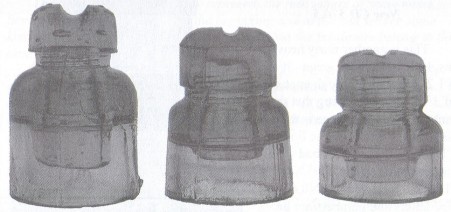
New CD's 568.6, 568.7, and 568.8
All three of the these next insulators are unembossed. CD 568.6 on the left
is 3-1/2" tall with a base diameter of 2-3/8". It is a pretty delft
blue with two small raised dots on either side of the conductor groove, plus one
in the middle of the front skirt and another on the rear skirt right near the
base. I've been scratching my head wondering what those dots were for?? All
explanations or guesses are welcome.
CD 568.7 is in the center of the photo. It
is 3-1/8" tall and has a base diameter of 2-3/8". The glass color is
green aqua with swirls of golden amber running all through the insulator, which
makes it very attractive.
CD 568.8 on the far left is another insulator in
pretty delft blue. It measures 2-5/8" in height and the base diameter is 2-3/8".
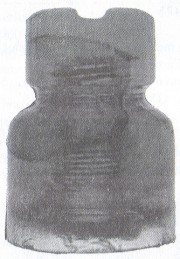
New CD 570.5
CD 570.5 has no embossing but it does have character! The glass color is a
dark Hemingray blue with lots of black "steam" in the dome and a large
swirl of it going down through one side of the skirt. Obviously some graphite
got mixed in as the glass was being poured into the mold. The insulator is 3=1/2" tall and has a base diameter
of 2-1/2".
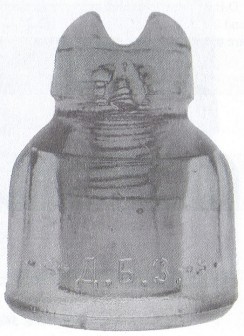
New CD 579.5
This is another fairly heavy insulator in medium green. It is 4-1/2"
tall with a base diameter of 3-3/8". It's interesting that the embossing on
this piece is the same as the letters on the little CD 547 that was described
earlier in this article, i.e. "D.B.Z." followed by "NO 6".
The letters and numbers are the
same size, though there is a big difference in style and height
of the two
insulators. The embossing probably refers to the name of the factory that
produced both of these insulators - but who were they and where were they
located?
Many thanks to Quenton Marty of Minneapolis, Minnesota and
Dan Shattuck
of Indianapolis, Indiana for making it possible to show these Ukrainian
insulators to Crown Jewels of the Wire subscribers. The best information I have
is that the five embossed insulators included in this article were made before
the year 1920.
Hey Quent,
I hope you like the insulators I send you. I'd like to give you
some of my conclusions (as of the country's citizen) of the date of production
and origin of some of the insulators.
The inscription "OXPAH SSID.No
49515" (protected certificate N 49515) tells us that the permit for the
insulator production was registered and that leads us to sometime before the
communism, before 1920.
The production of this kind of insulators was a private
business, what was impossible during the Soviet times. Another inscription
"HBMAHB 3" (Nyemon) on the other side, supports the idea of the time
the insulator was produced (the last letter "b" was not pronounced) at
the end of the word and the 2nd letter "b" (reads "ye") had been
in use before 1918.
The insulator with the inscription "E.GOLCHBEB"
(E. Golubyeu (or "v"), also was produced by a private firm (Golubevb),
seems to be the last name of a producer sometime before 1918. The last name ends
with the letter 6. That way of writing had been in use before 1918.
After 1918
the rules of grammar were changed, so last name "GOLCHBEB" would have
been written without the "6" after 1918.
The inscription "D.B.Z"
may represent the first letters of some name, family name, and last name. In the
beginning and at the end we see some kind of figured edging and that also may
tell that the insulators belong to the time before 1917.
According to the 2nd
version after the revolution of 1917 all the factories that had had sole
proprietorship were nationalized and it seems they started producing insulators
with the inscription "D.6.3. " on the old equipment. That may mean
the insulators were produced sometime in the beginning of the 1920's.
Though
there's no inscription referring to the year of production, the grammar and
inscriptions themselves tell us they'd been produced before 1920.
Quent, I hope
some of the information given here will be useful for your business.
Sincerely,
Oleg
| 